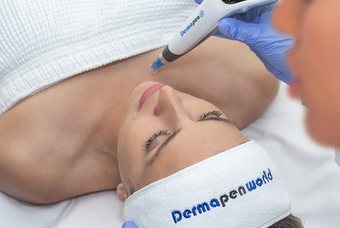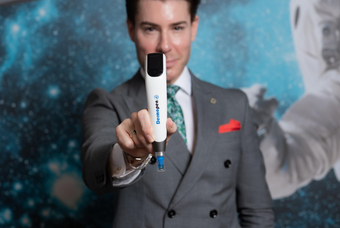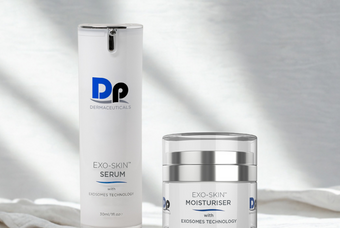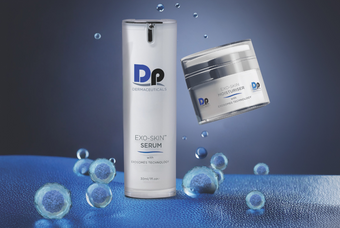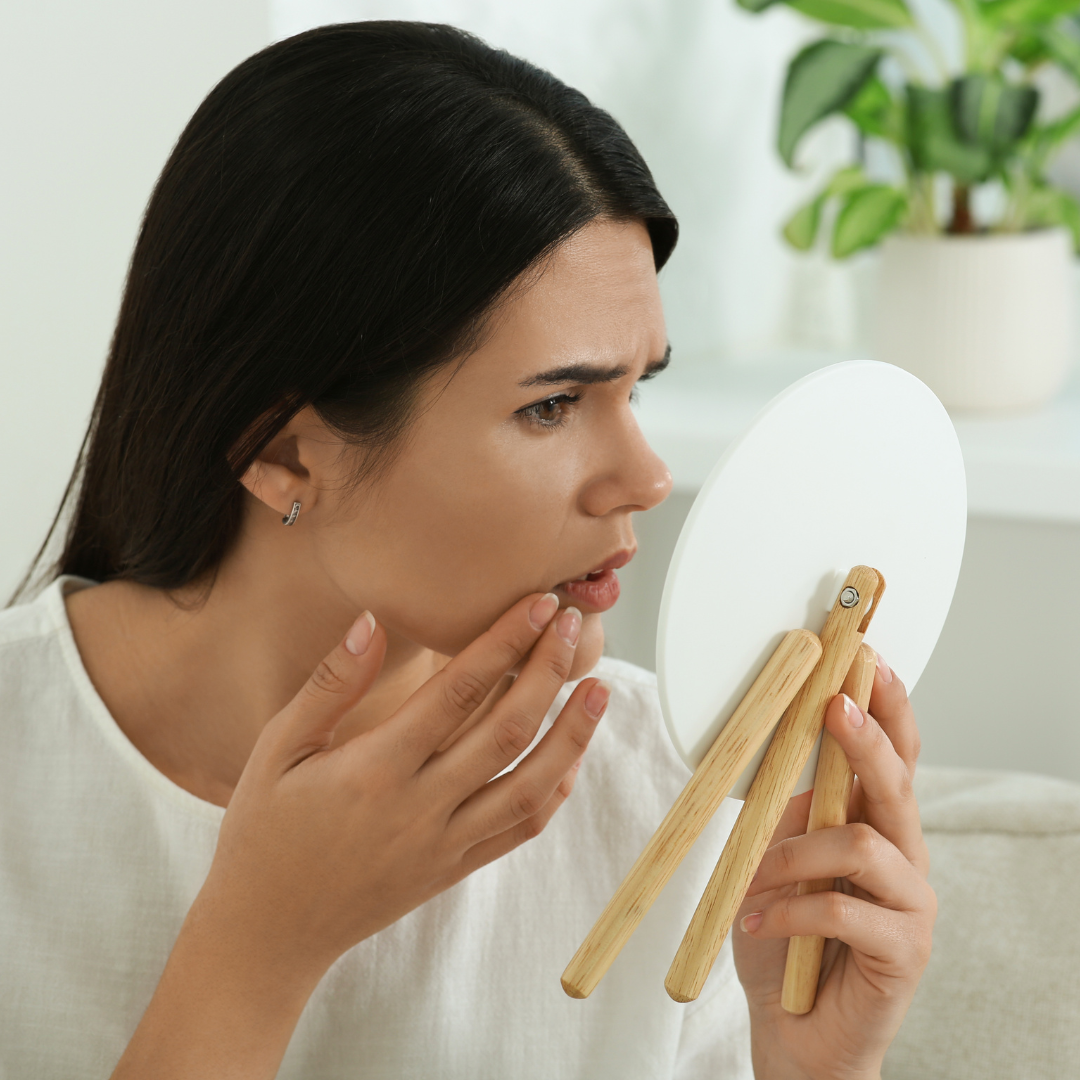Age, as they say, is just a number, yet our skin sometimes tells a different story. If you feel that your skin is lying about your age - and not in a good way - this article may better help you identify what is causing this and how to stave off and even reverse signs of aging.
Normal Aging vs. Premature Aging
While gradual changes to facial structure and skin laxity are normal signs of aging, the early and seemingly sudden onset of markers such as wrinkles or jowls might be indicative of premature aging.
Premature aging can show throughout the body, and include symptoms like thinning hair, memory loss and decreased ability to hear well ahead of the normal aging timeline. However, signs of aging are most visibly evident on skin, making them hard to ignore or cover up like some of the other signs.
An example of premature skin aging.
For individuals in their 30s, a sign of premature aging on the skin could be the appearance of deep-set wrinkles, especially in areas that might usually show such signs later in life, like the forehead, between the eyebrows, or around the mouth. Typically, the 30s may see the onset of fine lines, but deep wrinkles are usually reserved for later decades.
The Three Signs of Skin Aging
Skin Laxity
Settle in as we will spend a bit more time in this section because it is the key component to understanding aging and how it appears on our skin. It will also give us some clues on what may be causing premature aging and how to address it.
Understanding Collagen and Elastin
As we age, collagen and elastin production decrease, contributing to wrinkles and skin laxity challenges such as jowls.
Both collagen and elastin are critical proteins in our skin. While collagen provides strength for skin’s integrity, elastin contributes to the skin's elasticity, allowing it to return to its original state after being stretched or compressed.
Here's a breakdown of their reduction through the decades so you can better understand if the skin laxity you’re experiencing is normal or premature:
- Twenties:
- Collagen: Production begins to slow down in the late twenties at a rate of about 1% per year. The skin remains relatively supple and resilient at this stage.
- Elastin: The skin retains its elasticity well, but damage due to sun exposure and other environmental factors can start breaking down the elastin fibers, though the signs might not be visible yet.
- Thirties:
- Collagen: The reduction rate continues at 1-2% per year. Fine lines might start appearing, especially around the eyes and mouth.
- Elastin: The cumulative damage to elastin fibers becomes more evident, leading to decreased skin elasticity. The skin might not bounce back as quickly after being stretched.
- Collagen: The skin loses its firmness due to the continued decrease in collagen, which might drop by up to 15% over the decade. Deeper wrinkles and lines become more noticeable.
- Elastin: The breakdown of elastin fibers accelerates, and the skin's elasticity diminishes further. This can lead to more pronounced sagging, especially around the neck and jawline.
- Collagen: Post-menopause, women experience a sharper decline in collagen levels due to the significant drop in estrogen levels, which influence collagen production. The skin becomes thinner and less dense.
- Elastin: The skin's ability to return to its original shape is significantly reduced as elastin production continues to decline. This leads to further sagging and loss of elasticity.
External factors like excessive sun exposure, smoking, poor diet, and stress can exacerbate the decline in both collagen and elastin production.
While the above is the ‘normal’ progression of aging, we live at a time where we are able to not just mask signs of aging, but reverse them on a cellular level! Keep reading to see how.
Fine Lines & Deep Wrinkles
These markers are due to skin laxity described above. Fine lines may appear in your late 20’s, especially around the mouth and eyes, but deep wrinkles are typically reserved for the mid-30’s and early 40’s.
While some individuals are genetically predisposed to premature aging, it is important to look into other factors such as lifestyle and environmental exposure before chalking it up to genes alone.
Lackluster Appearance
Dry skin may seem like a regular skin challenge, but did you know that the skin’s ability to retain moisture is actually a sign of aging?
Youthful skin has a robust lipid barrier that helps retain moisture, keeps the skin hydrated and helps give it that radiant glow. As one ages, this barrier can be compromised, leading to dryness and a more aged appearance.
Here are a few things that begin to happen in our late 20’s but are more visible in early 30’s:
- Loss of Natural Oils: Sebaceous glands produce less oil as we age. The natural decline of these oils can lead to drier skin. When skin becomes dry, it can exacerbate the appearance of fine lines and give the skin a rough texture, both of which can contribute to a prematurely aged appearance.
- Reduced Skin Cell Turnover: Young skin has a rapid cell turnover rate, meaning old cells are regularly shed and replaced by newer, fresh cells. As we age, this turnover rate slows down, leading to a buildup of dry, dead skin cells on the surface. Vitamin A-based products (think Retinol) can help.
- Decreased Hyaluronic Acid (HA) Production: Since HA has an exceptional ability to retain water (it can hold up to 1,000 times its weight in water), a decrease in its levels leads to reduced skin hydration, which can cause or exacerbate skin dryness. Hyaluronic acid provides volume by helping to retain moisture within the skin. Reduced HA levels mean less volume, which can lead to skin looking more sunken or saggy.
How To Address and Prevent Premature Aging
Now that you have an idea of signs of aging to expect when and what causes them, it’s easier to understand how to address and stave them off.
__________
If you’re ready to address signs of aging now, we include the age-defying, clinic-grade skin care products you need in two easy-to-use kits:
Anti Aging Starter Kit contains a 14-day supply of six science-backed, age-defying products. It is the best anti aging skincare kit for an introduction to Dp Dermaceuticals products.
Age-Defying Skin Set is ideal for skintellectuals committed to seeing results and contains five full-sized, science-backed products that can last up to 60 days with daily use. It also boasts a savings of $95 over buying each product individually.
__________
Let’s dive into specific products and tips for anti-aging.
Hydration
Hydrating the skin is paramount in addressing and preventing signs of aging. A cornerstone in modern skincare, hyaluronic acid (HA) can significantly boost skin hydration, plump up fine lines, and impart a youthful glow.
It’s important to choose hyaluronic acid skin care products that give your skin the best hydration. Dp Dermaceuticals Hyla Active serum uses triple-weighted hyaluronic acid and its patented HylaFuse delivery system, hydrating multiple layers of tissue.
As skin loses its ability to retain moisture, it is also important to incorporate products that strengthen your skin’s natural barrier function. This means that the ingredients should be biocompatible. The best moisturizer for dry skin is Dp Dermaceuticals Skin Veneer which combines key ingredients like Squalane, Triglycerides and Hyaluronic Acid to not only replenish moisture, but to also seal it in.
Beyond topical treatments, make sure you’re hydrating enough for your activity level. Hyaluronic acid is a humectant, which means it pulls water to its molecules - but it needs water to pull to it. Keeping yourself hydrated daily is key to helping your skincare work well.
Omega-3 fatty acids, found in fish, walnuts, and flaxseeds also bolster the skin's lipid barrier, helping to lock in moisture. Antioxidant-rich foods like berries, spinach, and nuts can further combat free radical damage, which can dry out and age the skin.
Lastly, consider your environment and lifestyle. Use a humidifier if you're in a dry environment, avoid excessive caffeine and alcohol, both of which can dehydrate, and always, always wear hydrating sun protection to prevent the drying and aging effects of UV exposure.
Collagen & Elastin
Ingredients that support collagen production, such as vitamin C and peptides, can help maintain skin's firmness.
Dp Dermaceuticals Vitamin Rich Repair and Retinal is a must-add to your skin care regimen. With ingredients like Vitamin C, Vitamin E, and Copper Peptides, you’re turning back the clock each time you use this.
Retinal Active is our go-to formula for effectively reducing wrinkles and other signs of aging, and it’s gentle enough for daily use.
Ready to start? Consider the best anti aging skincare kit.


